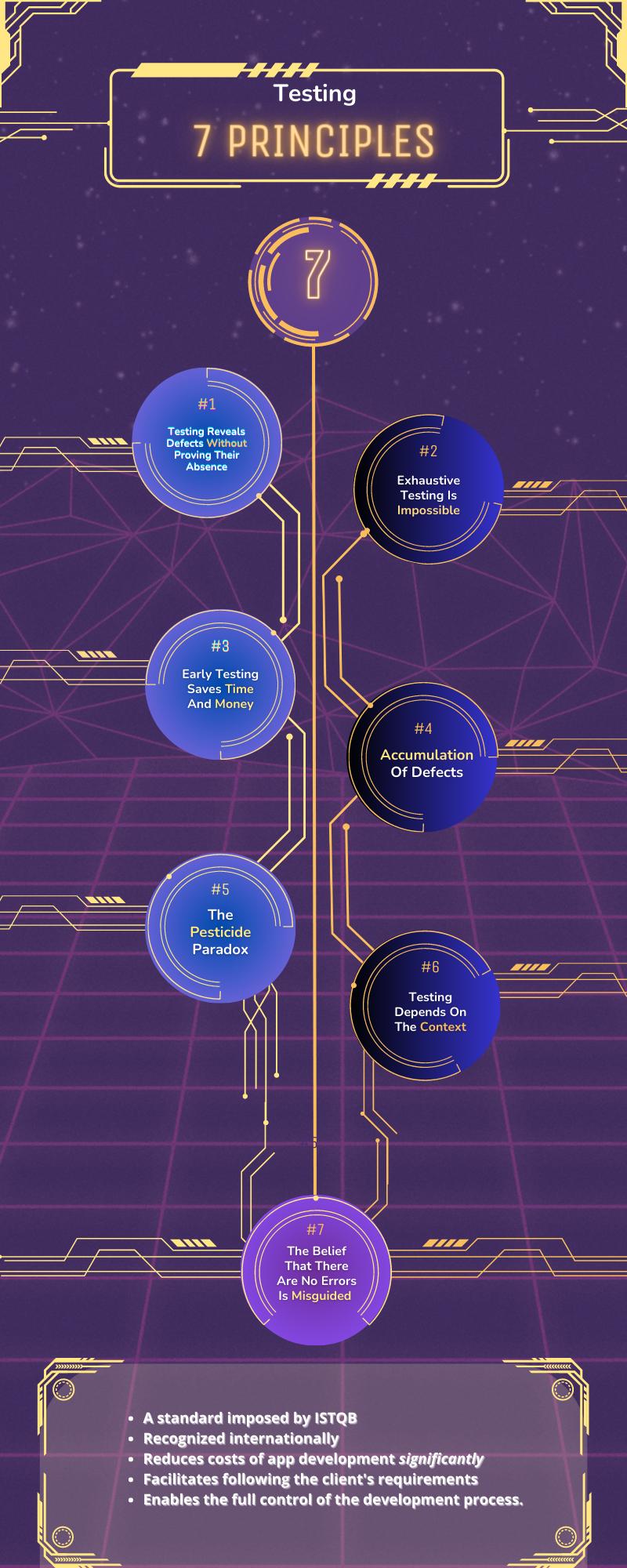
7 Principles of Software Testing - Effective Bug Detection According to the ISTQB Syllabus
It is the programmer's job to produce software; in turn, it is the job of testers to find, report and fix code failures. It sounds trivial at first. However, as the application structure becomes more complex, fixing it becomes a challenge. Thus, the testing process is subject to certain essential principles that constitute good practices in Quality Assurance. Let us see the methodologies and discover how to ensure the system works according to the guidelines.
From this article, you will learn the following:
- What purpose does conducting QA testing serve,
- Whether testing proves the absence of defects,
- Whether we can conduct exhaustive testing,
- Whether it is worth testing in the early stages of software development,
- What defect accumulation means,
- What is the pesticide paradox,
- Whether the context can influence the form of testing,
- Whether the absence of bugs in the code guarantees the usability of the application,
- Is it worth introducing the seven principles of software testing into the workflow?
Seven Principles Of Software Testing - The Basis Of A Tester’s Work
Many professions are subject to numerous regulations or rules to create standards for work. That is also the case for a software tester. At the beginning of your journey as a junior, you learn about the general rules imposed by the syllabus of the ISTQB (International Software Testing Qualifications Board) software testing certification board.
It is a recognized international institution that has issued about 845,000 certificates in more than 130 countries as of April 2023. Taking the ISTQB exam demands in-depth preparation in terms of knowledge of the testing process in the Agile methodology.
Why Is Testing Important?
The testing process helps ensure the highest quality of software. That, in turn, translates into the correct operation of the assumed functionalities. The best-optimized applications are created by finding bugs and eliminating them at various stages of the development process. A great help in this regard is the Test Driven Testing methodology, which you can read about on our blog.
What is the purpose of application testing? First, regular testing reduces the cost of fixing bugs at the final stage of product development. It also provides complete control over the development process by assessing the overall quality of the project. That ensures that the application functions following customers' requirements - and thus, serves the development of their businesses. Therefore, it is vital that testing undergoes industry requirements imposed by certified institutions.
According to the ISTQB syllabus, seven general testing principles set the standard in our industry. Let's get acquainted with them and find out how we ensure the systems we release are high-class.

Testing Reveals Defects Without Proving Their Absence
Through testing, the team can reduce and limit the number of defects. However, testing everything to prove it is 100% fault-free is downright impossible. Instead, a good practice is to have more than one person test the application. Every person has a unique approach and work methodology. That makes cooperation a vital component of efficient defect detection.
Exhaustive Testing Is Impossible
Testing teams aim to detect as many defects as possible to make the application, website, or module work smoothly. However, it is usually impossible to test all the possible combinations. Sometimes the path to discovering bugs is very complicated. The risk increases exponentially with the complexity of the application. In such cases, defects occur only under specific conditions. That, in turn, makes it impossible for us to predict the combination of inputs and preconditions in the system our team is building.
With that in mind, we focus on the most vital functions and carefully design the test phases. Good management is a component that allows us to optimize time and resources to get the best possible results by the end of testing. Even the best tester cannot predict all inputs and conditions. Therefore, let's not set unrealistic requirements and expectations.
Early Testing Saves Time And Money
Early-stage testing is standard in the Agile methodology for virtually any type of software. You can read more about shift-left testing or the benefits of hybrid applications here. However, let us now consider implementing it to reduce the cost of software development and mitigate the risk of completely rebuilding the software, thus increasing the time to introduce it to the production environment. It's also worth mentioning that static and dynamic testing - as early as possible - allows for effective error detection.
Accumulation Of Defects
The principle of defect accumulation states that most defects will appear in particular areas or modules of the software. In this case, the testing team will focus most on such observed clusters of defects. Some experts point to the occurrence of the Pareto principle. In this case, we interpret it as 20% of the modules are responsible for 80% of the bugs that appear.
Being aware of such correlations, we can estimate the risk of defect-rich areas at the test-planning stage and emphasize testing them. That will apply in large or complex systems where a module has, for example, many dependencies and connections with other system elements.
The Pesticide Paradox
This rather vivid name hides a vital principle to apply at every testing stage. Why the "pesticide" paradox? These substances cease to be effective in eliminating pests over time. Similarly, in the case of software testing, repetition of the same tests leads to a weakening of their ability to detect bugs.
That is a rule of thumb informing that continuous execution of the same tests can become ineffective. At some point, the tests will fail to detect defects. Therefore, we take into account any differences in the software testing process. It is worth updating the test process and its cases and topping it up by cyclically changing the test data.
In manual testing, we observe it when, due to routine and boredom, a tester performing the same test, one time after another, may miss a bug in the code. In turn, a new person with a fresh approach will find them.
Testing Depends On The Context
The ways and methods of testing depend on the software system that undergoes the QA process. This aspect determines our approach - depending on the test subject, we may emphasize performance, security, or availability testing, among others. For example, e-commerce systems undergo a different approach than critical infrastructure software.
The type of application that will meet your business needs is a debated subject during our Discovery Workshop session. Learn how we can help you produce a product that will measurably support your business.
A skilled tester knows that testing is performed differently depending on the situation. We need to be flexible to detect and eliminate most failures. This paradox applies in more cases of high-level tests performed in the system and acceptance testing phase.
The Belief That There Are No Errors Is Misguided
The last principle we discussed is closely related to the previous ones:
It emphasizes the importance of the developed software’s usability. Of course, testing reduces the likelihood of releasing an unstable system. However, even sparse defects do not guarantee the success of the released product. If it does not cover the end user's needs or is unintuitive, further implementation of such a system is impossible. Therefore, finding all the bugs must stand along with ensuring that the team's proposed application functions according to user requirements.
7 Rules - To Follow Or Not?
For our part, the answer to this question is: by all means! The above rules are a determinant of quality, thanks to which we are sure that the application we propose works following the requirements of both customers and end users. Adhering to them makes us keep an eye on the entire development process, and we can fix errors in advance in places that are crucial to the project.
Do you look for expert mobile app development providers? See our offer and take your business to the next level!
Share this post:

Stay updated with new posts
Get notifications when new articles are posted. You can always unsubscribe from the list.
Softnauts is committed to processing the above information. Read Privacy Policy

